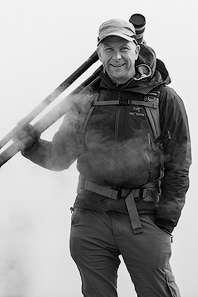In October of 2011 Zack Schnepf and I took a very productive and enjoyable excursion to White Pocket, in the Vermilion Cliffs National Monument of northern Arizona. White Pocket rock formations have a unique strangeness and visual intrigue, like a place not of this planet. Zack and I spent four days burning through media cards in a rash of creative intensity. While the landscape itself was energizing, our experience was made even more special by spectacular purple/orange light that would bathe the landscape about 15 minutes before sunrise and 15 minutes after sunset each day. We had both experienced similar light before, but it was so powerful in this location that we came up with a name for it: salmon light.
All of these images were taken during the salmon light phase and they feature a similar magenta, pink or orange ambient glow emanating from high in the atmosphere. The actual light intensity during the salmon light phase of twilight is very low. Photographing at this time requires long exposures, but what those long exposures reveal is beautiful.
Later in that same trip I experienced more salmon light at Coyote Buttes South and Valley Of Fire.
Looking back I also recall salmon light in the Tetons in September 2011 as well as several other occasions in the mountains, deserts and in Hawaii over the years.
People have assumed that the affect of salmon light is something I create with image developing techniques. While I certainly take creative advantage of such light in my developing, the basic effect is natural. In Valley Of Fire in Nevada I decided to take some comparison images to show how dramatically the light changes from sunset to the salmon light period. The following two images have been converted from the raw files with nothing more than a slight contrast adjustment. The first was taken just after the sun went down with light still illuminating the clouds on the skyline. The second image was taken about 20 minutes later at the peak of salmon light.
You can see how the quality of light has changed. The first image has less color and doesn’t feature the characteristic ambient glow. What you can’t see is how much darker the scene had become that long after sunset. The light in the second image is four stops darker than in the first so it required a shutter speed 16 times longer to achieve the same exposure value.
Curious about what might cause this light phenomenon and how I might be able to hunt down more of it I did some internet research. I found an informative article by Stephen F. Corfidi from the NOAA Storm Prediction Center. What Zack and I call salmon light he calls “lilac afterglow”. According to him it is caused primarily by sunlight reflecting off particles of dust and sulfuric acid droplets that have been ejected into the stratosphere at altitudes of 12 to 18 miles by volcanic eruptions. It occurs most vividly in deserts, on islands and at high altitudes where the air quality is most clean. This volcanic twilight or “afterglow” occurs about 15 minutes before sunrise and after sunset when the lower troposphere is in shadow but particals in the stratosphere are still being illuminated by sunlight that has passed through the lower atmosphere beyond the horizon. The glowing layer of high altitude particles reflects a smooth colored light that washes the entire landscape.
I wondered if 2011 had more than its share of volcanic eruptions so I visited the Smithsonian Global Volcanism Program website. Without crunching the data it is hard to tell if 2011 was a particularly big year for volcanoes but there were many eruptions around the globe as well as the large eruptions in Iceland in 2010. Next time I’m in the high Arizona desert in the fall I will make note of the what the salmon light is like to see if we experienced a greater than normal degree of volcanic twilight.
While it may be difficult to accurately predict when salmon light will occur, I know where I’m more likely to find it. I also know I need to get out early and stay out late to be ready for the afterglow should it turn lilac colored. Volcanic eruptions are part of life on earth. I’m anticipating future volcanic eruptions like the one Mt. Pinatubo had in 1991. From what I have read, the volcanic twilight after that eruption was off the chart.

Sean is an outdoor photographer, digital image developing enthusiast and photography educator based in Ashland, Oregon, where he resides with his wife and two sons. His previous career as a science teacher makes photography education a good fit. Sean teams up with fellow Photo Cascadia members leading workshops. He also teaches digital image developing classes, lectures and offers a series of Photoshop video tutorials.
More posts by Sean Visit Sean’s Image Gallery Visit Sean’s Website









Recent Comments